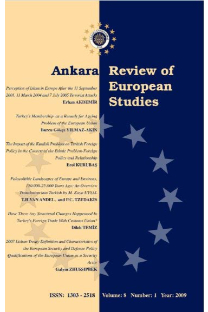DÖNGÜSEL EKONOMİYE GEÇİŞ DOĞRULTUSUNDA YENİ TEDBİRLER VE AB ÜYE ÜLKELERİNİN STRATEJİLERİ
Avrupa Birliği’nin (AB) kaynak-verimli, yeşil ve rekabetçi düşük-karbon ekonomisine geçiş hedefi doğrultusunda, kapsamlı bir eylem planını ve atıkla ilgili yasal düzenleme tekliflerini içeren “Döngüsel Ekonomi Paketi”, 2 Aralık 2015 tarihinde Avrupa Komisyonu tarafından kabul edilmiştir. Paketin kabul edilmesi sonrasında, 2018 yılının Ocak ayında söz konusu eylem planının hayata geçirilmesine yönelik olarak ilave tedbirler getirilmiştir. Bu gelişmelere paralel olarak, döngüsel ekonomiye geçiş doğrultusunda bazı Üye Ülkeler tarafından da önemli stratejilerin kabul edilmeye başlanıldığı görülmektedir. Bu derlemede, Avrupa Birliği’nde Döngüsel Ekonomi Paketinin kabul edilmesi sonrasındaki gelişmelere ve yeni tedbirlere değinilerek, bazı üye ülkelerin stratejileri incelenecektir.
The Recent Measures and The Strategies of The EU Member States Towards Circular Economy Transition
In line with the European Union’s (EU) objective of transition towards a resource-efficient, green and competitive low-carbon economy, the Circular Economy Package, which includes a comprehensive action plan and legislative proposals for waste was adopted by the European Commission on December 2, 2015. Following the adoption of the package, additional measures were introduced in January 2018 to implement the action plan. In parallel with these developments, it is seen that important strategies have also been adopted by some of the EU Member States to support this transition. In this review, the developments and the recently adopted measures in the EU following the adoption of the Circular Economy Package will be mentioned briefly and the strategies of some of the Member States will be analysed.
___
- Buruzs, Adrienn ve Torma, Andras. “A Review on the Outlook of the Circular Economy in the Automotive Industry”. International Journal of Environmental, Chemical, Ecological, Geological and Geophysical Engineering (2017),11(6): 576 - 580.
- “Circular Economy in the Netherlands by 2050”. Erişim Tarihi: Eylül 2, 2018.
- https://www.government.nl/documents/policy-notes/2016/09/14/a-circular-economy-in-the-netherlands-by-2050.
- Ellen MacArthur Foundation (EMF) and McKinsey Center for Business and Environment. “Growth Within: A Circular Economy Vision for a Competitive Europe”. Erişim Tarihi: Haziran 10, 2018. https://tinyurl.com/jec5ykg.
- Esposito, Mark, Tse, Terence ve Soufani, Khaled. “Is the Circular Economy a New Fast Expanding
- Market?”, Thunderbird International Business Review, 59(1): 9-14.
- “EU Circular Economy Stakeholder Platform- Strategies.” Erişim tarihi: Eylül 2, 2018. https://circulareconomy.europa.eu/platform/en/strategies.
- European Academies Science Advisory Council (EASAC). “Circular Economy:
- A Commentary from the Perspectives of the Natural and Social Sciences.” Erişim Tarihi: Eylül 6, 2018. http://www.easac.eu/fileadmin/PDF_s/reports_ statements/ EASAC_Circular_Economy_Web.pdf.
- European Commission. “Closing the Loop - An EU Action Plan for the Circular Economy”. Erişim Tarihi: Haziran 26, 2018. https://eur-lex.europa.eu/legal-content/EN/TXT/?uri=CELEX%3A52015DC0614.
- European Commission. “Annex to the Circular Economy Implementation Report”. Erişim tarihi: Mayıs 10, 2018
- http://ec.europa.eu/environment/circular-economy/implementation_report_annex.pdf.
- European Commission. “Circular Economy”. Erişim tarihi: Mayıs 28, 2018. http://ec.europa.eu/environment/circular-economy/
- European Commission. ”A European Strategy for Plastics in a Circular Economy.” Erişim tarihi: Mayıs 12, 2018.
- https://eur-lex.europa.eu/legal-content/EN/TXT/?qid=1516265440535&uri=COM: 2018:28:FIN.
- European Commission. “Environment for Europeans Magazine”. Erişim Tarihi: Mayıs 11, 2018. https://ec.europa.eu/environment/efe/.
- European Environment Agency (EEA). “The European Environment- State and Outlook 2015.” Son Güncelleme: Ocak 14, 2016. https://www.eea. europa.eu/soer-2015/synthesis/report/1-changingcontext.
- Eurostat. “Circular Economy Indicators”. Erişim Tarihi: Temmuz 6, 2018.
- http://ec.europa.eu/eurostat/web/circular-economy/indicators/monitoring-framework. Eurostat. “Material flow accounts.” Erişim tarihi: Ekim 21, 2018.
- http://appsso.eurostat.ec.europa.eu/nui/show.do?dataset=env_ac_mfa&lang=en.
- “Finnish Roadmap to Circular Economy. “ Erişim tarihi: Mart 20, 2018.
- https://www.sitra.fi/en/projects/leading-the-cycle-finnish-road-map-to-a-circular-economy-2016-2025/#what -is-it-about. “German Resource Efficiency Programme.” Erişim tarihi: Mart 12, 2018.
- http://www.bmub.bund.de/en/topics/economy-products-resources-tourism/resource- efficiency/german-resource-efficiencyprogramme/overview/“La Transition Énergétique Pour La Croissance Verte”. Erişim tarihi: Mart 20, 2018.
- http://www.gouvernement.fr/action/la-transition-energetique-pour-la-croissance-verte.
- “Making Things Last: A Circular Economy Strategy For Scotland”. Erişim tarihi: Eylül 2, 2018. https://beta.gov.scot/publications/making-things-last-circular-economy-strategy-scotland/.
- Preston, Felix. “A Global Redesign? Shaping the Circular Economy Briefing Paper”. London: Chatham House (2012): 1-20. Erişim Tarihi: Ağustos 2, 2018. https://www.chathamhouse.org/publications/papers/view/182376.
- “Roadmap For The Circular Economy- France”. Erişim Tarihi: Eylül 2, 2018. https://www.ecologique-solidaire.gouv.fr/sites/default/files/FREC%20anglais.pdf. “Roadmap Towards The Circular Economy In Slovenia.” Erişim tarihi: Eylül 2, 2018. http://www.vlada.si/fileadmin/dokumenti/si/projekti/2016/zeleno/ROADMAP_ TOWARDS_THE_CIRCULAR_ECONOMY_IN_SLOVENIA.pdf.
- Sapmaz Veral, Evren ve Yiğitbaşıoğlu, Hakan. “Avrupa Birliği Atık Politikasında Atık Yönetiminden Kaynak Yönetim Yaklaşımına Geçiş Yönelimleri ve Döngüsel Ekonomi Modeli”. Ankara Üniversitesi Çevrebilimleri Dergisi 6(1) (2018): 1-19. Erişim Tarihi: Ağustos 29, 2018. DOI: 10.1501/ Csaum_0000000082. http://dergiler.ankara.edu.tr/dergiler/47/2274/23670.pdf.
- Sapmaz Veral, Evren. “Atık Sorunsalı Bağlamında Avrupa Birliği’nin Yeni Ekonomi Modeli Olarak Döngüsel Ekonominin Değerlendirilmesi” (Doktora Tezi, Ankara Üniversitesi, 2018).
- Wijkman, Anders ve Skånberg, Kristian. “The Circular Economy And Benefits For Society Swedish Case Study. An interim report by the Club of Rome with support from the MAVA Foundation and the Swedish Association of Recycling Industries.” Erişim tarihi: Temmuz 10, 2018. https://www.clubofrome.org/wp-content/ uploads/2016/03/The-Circular-Economy-and-Benefits-for-Society.pdf
- World Wildlife Fund (WWF). "Living Planet Report 2014- Species and spaces, people and places." Erişim Tarihi: Ağustos 11, 2018. https://www.worldwildlife.org/pages/living-planet-report-2014.
- “WRAP Vision for the Circular Economy UK”. Erişim Tarihi: Eylül 10, 2018. https://wrap.org.uk.
- ISSN: 1303-2518
- Yayın Aralığı: Yılda 2 Sayı
- Başlangıç: 2001
- Yayıncı: Ankara Üniversitesi Avrupa Toplulukları Araştırma ve Uygulama Merkezi
Sayıdaki Diğer Makaleler
Girişimcilikte Cinsiyet Farklılıkları: AB ve Türkiye
DÖNGÜSEL EKONOMİYE GEÇİŞ DOĞRULTUSUNDA YENİ TEDBİRLER VE AB ÜYE ÜLKELERİNİN STRATEJİLERİ
POLBUD KARARI SONRASINDA İŞ KURMA SERBESTÎSİNİN KAPSAMI VE ŞİRKETLERİN SINIRAŞAN TÜR DEĞİŞİKLİĞİ
Erasmus+ Programı ile Türkiye'den Gerçekleşen Uluslararası Öğrenci Hareketliliğinin Analizi
